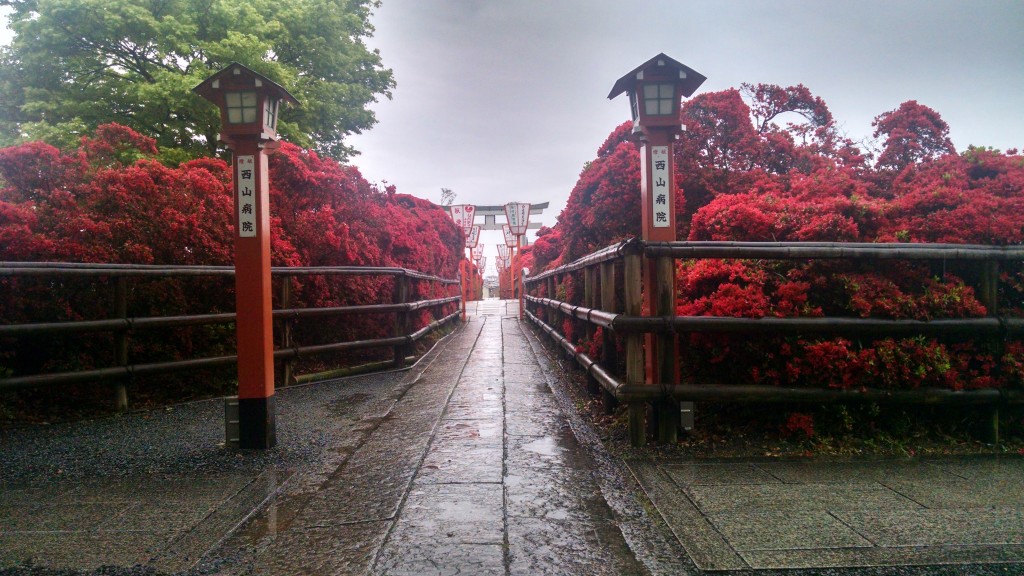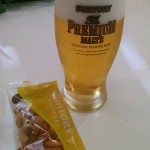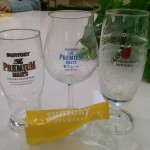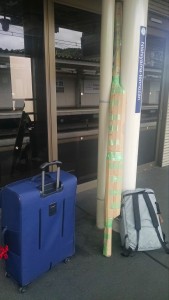Hi all,
I’m back in America. I’ve actually been here since Friday. The past week has been half tying up loose ends in Japan, half traveling, and half getting started back here in America. All together that adds up to a pretty full week (about %150 full).
This will also be my last blog post. I appreciate you all tuning in once in a while to give my blog a read. It’s been fun to write and update.
Let’s wrap it up.

A picture of the beer vats at Suntory Beer Factory.
Thanks to Japan’s easy-access beer vending machines, I’ve had many opportunities to compare all the major Japanese beers and come up with various opinions about them. Throughout my stay, my favorite was consistently Suntory.
Suntory actually has a pretty interesting history, starting almost 100 years ago by making Western-style liqueur in Japan (originally just Port). Since then they’ve created lots of different kinds of alcohol, including vodka, wine, one of the world’s best whiskys, Jim Beam bourbon, and beer.
I just recently found out that Suntory actually had a famous factory in my suburb of Kyoto: Nagaoka-kyo. So I had to go.
The factory was actually a 5 minute ride or 10 minute walk away from the station I used every day. The admission was free, and I went with a friend and her hostfamily.
- Where they bottle the beer.
- Another section of the bottling process.
We were only given a tour of where they made their flagship beer (The Premium Malt’s), but it still took us at least 3o minutes and two bus rides.
Felt like I was on How It’s Made.
All this was especially interesting to me because I’m far more familiar with how sake is made. I knew very rudimentary stuff about beer, but I was also surprised how far my vocabulary I learned from sake helped me understand the brewing process.
After the tour, there was a free tasting.
- The first beer. They even had snacks!
- One beer quickly turned into three (or four).
During the tasting I was finally taught how to pour a beer properly. At that point we were all easily impressed, but regardless I’m sure we all saw our tour guide in a new light after her demonstration. Halfway through I was also asked, as an American, to talk about any differences between American and Japanese beer. I wasn’t really a pro at either, but I gave it my best shot. I basically said that on the whole, when compared to American beers, Japanese beers were “very easy to drink.” This made me friends.
It’s funny how incredibly representative food and drink can be to a culture. I’ve experienced this first-hand selling sake. When you insult a country’s food/drink, it feels like you insult the entire culture. And when you compliment it, praise is carried along to the culture at large as well. Even if the Suntory prides itself on being a European-style beer brewed in Japan, this still definately holds true. Food and drink should never be underestimated.
By the time I got home I was still pretty happy from my tour, but I had to start packing.
I ended up shipping quite a lot home. What with accumulating a lot of things like bowls and clothes while in Japan and having things like winter clothes and books sent to me, it was too much to fit in one suitcase.
By Wednesday I had finally fit all my extra things in my last box. It was a big one. I would rather have sent two smaller boxes actually, but last time I went to the post office I was flustered and accepted the box they gave me when I told them “I would like to buy a box…,” regardless of size.
It ended up weighing about 20 kilograms. I feel like there’s no need to convert that, since 20 is a lot of kilograms and I feel like anything measured in kilos already has a sense of seriousness. Because my hostparents were out and my friends were busy, I walked it the mile-or-so to the post-office.
Or I tried to at least. 20 kilos is pretty heavy already, and add the fact that it’s an awkwardly-shaped 20 kilos–near impossible. So I decided to wait and rest my box at one of those concrete traffic control poles while I gathered up enough energy to get to the in-sight post office. While I was waiting there a car passed by and then stopped in front of me. An older woman called out “Oi! Oniichan! You alright?” I said I was, but she didn’t take that for an answer.
“You going to the post office? Come on, get in. That looks heavy.”
She got out and started to clean the back seat of her car for my box. She also wanted to take the box from me, but I was afraid it was a bit too heavy, so I put it in the back myself.
She drove me the 1 minute or so to the post office and chatted up a storm the whole way. It probably took 2 minutes longer than it should. The TV was on in her car (as it often is in Japanese cars) and the news coverage of the earthquakes in Kumamoto was playing. “Pretty scary, huh?”
“Yeah.”
“Yeah, lots of earthquakes in Japan. So sad. Do they have a lot of earthquakes in America?”
“Well, not like Japan really…”
“No I guess not. But you know what is scary in America? Shootings. Boy, shootings have been happening more and more lately. Very scary.”
“Yeah, I suppose so.”
She dropped me off at the post office and told my goodbye.
“Well, I hope I see you around here again. You staying in Japan for the long run?”
I told her yes because I didn’t feel like saying otherwise.
“Good! Your Japanese is great! Keep it up! See you around!”
And she drove off.
Last Tuesday was my last day at kyudo.
To be honest, it was a lot like any other practice day at sensei’s house. I don’t really remember how I did, and I suppose that’s not too important. The fun part was afterwords.
First, my friend brought her whole computer to practice just so she could give me the video she took of me on my last day. I didn’t ask for her to come or anything, but it was worth it. Check it out:
Those were my last two shots in the dojo. It was crazy to see how far I had come.
But the funnest part was actually wrapping up the bow for travel. After asking the Japan Post if they could ship my bow home (denied; too long), private companies (decided against it; shifty), and Canada Air if I could carry it on the plane (sensei’s recommendation–denied; it’s a weapon that is too long), it was decided that I would check it with my baggage. This meant of course that it had to be extensively packaged to prevent damage. All throughout, it took about 4-5 people at one time to pack everything correctly.
So, the first step. Wrapping it up the way I bought it.
- Unstring it and put it in a long cloth bag.
- Put that bag in another longer, fancier cloth bag.
- Wrap that bag with foam wrap and tape at the ends.
- Wrap everything with twine in a spiral from the top to the bottom.
- Zip-tie two strips of bamboo to the belly and back of the bow.
That was pretty good as it was, but Air Canada said that it needed to be in some kind of box or tube. Hearing this, sensei got a cardboard box and cut wide, 2-foot long strips, wrapping the cardboard around the bow one after the other until we reached the top.
Done. We congratulated ourselves and relaxed a bit. Then sensei said, “What about your arrows?” There was a brief silence.
“Well, I was going to send those tomorrow, since they’re not too long…”
“Doesn’t that take money?”
“Yeah, but it would also take money if I brought on another piece of luggage, since I’m already bringing on one piece of luggage and a bow.”
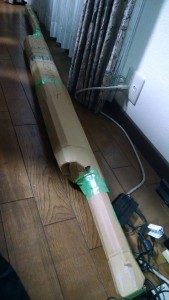
Here’s a picture of the finished product, on the floor of my hostfam’s dining room. Almost 8 feet long.
“Well, if we tape the arrows to your bow, wouldn’t they become one piece of luggage?” He had a point.
So we all got back up, taped my quiver full of arrows (after stuffing it with newspaper so it wouldn’t rattle) to my cardboard-wrapped bow, and wrapped a shell of cardboard around that as well.
Then we relaxed again. We measured it and labeled it (“So that they don’t ask you how long it is”), and sensei put the character for “bow” on it: 弓. It was very small. So small that hostmom cracked up when she saw it at home.
It was time to leave. On my long way out, sensei and other students made sure I was set if I wanted to practice in America. 6 extra strings, 6 extra nocks and arrow tips, a chest protector, a tube full of hand powder, and a piece of wood I could screw into the wall to help me string my bow.
And then I said goodbye. Sensei didn’t make too big of a deal about it and just said, “Well, see you next year. Or whenever you make it back. Keep it up.”
The others had a similar attitude. I shut the door and walked to my usual station. It was a bit of a chore, not because the package was heavy (it was actually really light), but because it was so long. It was just a bit to tall for the train. I got lots of looks but I just wanted to direct them to sensei’s “弓.” Not that they could have seen it.
My second-to-last day, I went to the Raku Museum. For about 500 years, the Raku family has been making amazing teabowls. I’d been wanting to visit there for months, but finally decided to do it two days before I left.
Absolutely breathtaking. Unfortunately, I can’t find a video of the process on youtube–only videos of American raku-workers or other derivatives. I won’t go into detail here. I recommend looking at the slideshow of pictures on the link above and exploring the museum website.
I ended up making a memory not advertised on the website, though. There was an American couple in the museum trying to ask questions to one of the staff members in English. I was nearby so I tentatively offered to help. I ended up helping quite a bit, although my vocabulary wasn’t quite there.
After the couple left, I talked to the staff member a bit. He was very thankful for the help, even if it was a bit clumsy in places. He asked me a few questions and I told him that I was a Doshisha student. One of the last times I’d be able to do that. I also told him that I practiced tea–specifically Yabunouchi, a very Kyoto-centered school. He was impressed and told me to please come back to the museum whenever I was back in Kyoto.
It really made me realize that out of all the things I’ve enjoyed most in Kyoto, it’s the personal relationships that are the most memorable and the most treasured. I’m not sure why it happened so much while I was in Japan, but it’s one thing that I’d like to try doing back in America.
My last last day, I went to the Toji fleamarket. I needed to see it one last time. I also wanted to check out the booths again to see if there was anything that I needed before I went home. After much wandering, I ended up picking up a red natsume and a cheap chashaku.
I also filled up the last page in my goshuincho! It worked out perfectly. Also while I was waiting I bought a pocket-sized, readable Heart Sutra (which I had been wanting for a while) and a cool towel that was an illustrated version of the Heart Sutra, with pictures rather than characters.
It was raining, so there weren’t too many people and I could look pretty freely from booth to booth. I just had to be careful of umbrellas. On the way out I wanted to sit down a bit and gather my things. I sat down on a bench inside one of the gates.
There was a lady who was selling drinks nearby. She saw me sit down and asked me quickly if I wanted to drink. I didn’t quite catch her, so I asked her to say it one more time. “One drink?” she said in English. I was a little surprised, and she had a pretty strong accent so I just said “sorry” in Japanese. She said “One drink?” in English again. This time I understood her, but I didn’t want a drink, so I just said “sorry” again and waved my hand. She heard this and gave me a disgusted look, turned away, and said to herself (pretty loud), “Ug… Doesn’t have a clue.” That hurt.
That had to have been one of the first times, if maybe the only time, I’d been dismissed like that. I guess it had to happen sometime. I took my stuff and walked out.
I walked around a bit, and I have to say I really appreciated how few people there were and the smell of the rain on concrete.

Later on my last day. Nagaokatenjin.
Later that day I did something I’d been planning on doing since the beginning of my time at AKP. Finally get rid of all the 1 and 5 yen coins that I can’t use for vending machines, public transportation, and even pachinko parlors (not that I went to any).
I did it in the best way I knew how: donating them to my local shrine as offerings. In the end it probably wasn’t that much, maybe 2-3 dollars worth (about 200 coins/enough to fill a small jam jar), but considering most people donate on average 5 cents a visit, it wasn’t a bad offering overall.
It was still raining, and because of that there weren’t too many people at the shrine. This was good for me, since tossing hundreds of coins from a jar isn’t that common. I walked up to the big shrine (pictured above), put my umbrella down and took out a big handful of coins. I tossed them in, said my prayer, and realized I still had like 5 or 6 handfuls left. Luckily, there are mini-shrines to other deities around the side of the main building, so I went around to the left and put a handful in each of the the three other shrines I found, giving a small prayer each time. I realized there were still a few handfuls left so I took a small walk around the shrine grounds.
Nagaokatenjin really is my favorite shrine in Kyoto. It was one of the first ones I went to, and it was where I stumbled across a local music festival early-on. That was a good day. That was actually the first time I found Nagaokatenjin. That meant I was able to see it during each of the seasons. I even went to it to ring in the New Year. It has a beautiful park as well. It’s truly a wonderful example for other shrines in Japan. Many shrines are suffering a bit trying to find their place in modern Japanese society, but Nagaokatenjin has turned into a massive public space. A place for festivals, walks, running–there are even tennis courts and a baseball field.
I walked all the way around the park and came around the other side of the main building. Luckily, there were two more mini-shrines on the right side as well. I had almost exactly two handfuls left. I dropped my coins in the boxes, said my prayers, and left.
It was a good day to visit and I hope I get to come by again. Maybe I’ll get there in time for another festival.
My last night was spent cleaning and packing.
While cleaning up my closet, I realized that I still had a few things from Christmas that my mom sent me; I just never pulled them out. Among them were a light-up Rudolph nose and a toy sheep that pooped out jelly bellies (luckily I found a video of the exact sheep here). I wasn’t sure if hostmom wanted them, but I decided to ask just in case. Great idea.
I walked downstairs after dinner and hostmom was writing in her diary at the dinner table. Hostdad was asleep on the couch with the TV on. First up was the Rudolph nose.
Hostmom was a little confused about what it was at first, but after I explained a bit and demonstrated she said it looked fun. I handed it over and she tried it on. Unfortunately, I guess those Rudolph noses just weren’t made for Japanese noses. It smooshed hers right down, and when she tried to talk all that came out was a high, nasal voice. She laughed and then got serious and explained, “you know, it seems like it just might not be made for Japanese noses,” with the nose still on. She continued to talk like that for a little while. It was absolutely hilarious and I couldn’t stop laughing. She cracked up once or twice too, but she kept her poker face pretty well throughout, which made it funnier. She said she’d keep it for the kids.
Next was the pooping sheep. It took a little while to unwrap, but when we finally did I showed her how to open it and how to put the jelly beans in. Then, in a moment of glory, I pushed down on the sheep and out pooped a brown jelly bean. Hostmom’s eyebrows furrowed in slight confusion.
There was a slight pause.
“Huh.”
And then we both laughed.
“Wow, that’s awesome. You can’t eat them though, right?”
“No, check this out!” And I ate one. It was good.
“No way.”
“Yes way.”
She tried one.
“Oh! These aren’t bad.”
I’m not sure if hostdad will understand it, but she said she’d save it for the kids too. Actually, he’ll probably love it. It was a good last night.
I woke up early the next morning to pack a bit more, clean, and say goodbye to hostdad.
He was headed off to his job early that Friday morning as usual, and I woke up just in time to see him go. No speeches, just goodbye and a hug. He left and I remembered that he was actually the first one to welcome me in to the house. Pretty crazy.
I packed up a bit more until I was ready to go, and then I gave hostmom a note I’d written her earlier. I didn’t really have anything else to give her, and I didn’t really know what they would want from me anyway, so I just concentrated on writing a nice note. I think the Japanese was a little shifty, but I felt that the meaning was there. I didn’t really intend for her to read the note while I was there, but when I came back down from the bathroom, she said she’d read it and that she understood it. It looked like she did. Then she gave me a letter. Honestly, even now I haven’t had the heart to read it yet. Soon, though.
We walked to the local train station together, her holding my bowpackage and me with my suitcase and backpack. We didn’t talk about too much, but the mood was light and it was very cute to see her barely 5′ frame carrying something so disproportionately long. She walked to all the way to the ticket gate, and then we hugged and said goodbye. I may have teared up a little bit. She was fine, though. I think she’d gotten it out the night (or weeks/months) before. I couldn’t get through the gate carrying all my luggage, though, so I went through first and then hostmom fed the bowpackage through to me afterwords.
I waved goodbye and set off, on the Osaka-bound train.
My luggage situation was rough. It later turned out that my suitcase was 32 kilos (70.5 lbs), and that coupled with my 8-foot long bow and bulky backpack, I got a lot of looks. Also because of this, I decided to take only local trains because they were less crowded. I would have taken a taxi or a shuttle, but they wouldn’t accept my reservation because of my bow.
After eventually arriving at Osaka Intl. Airport and waiting for the International Connections desk to open up (I got there an hour early at 11pm), I finally was able to check my bags. I was a little worried about the length/content of my bowpackage and the weight of my suitcase, but everything turned out totally fine. They took my bow and slapped a “Fragile” sticker on it and told me it would be fine. As for my baggage, the clerk leaned real close and told me quietly, “You know, just today, I’ll cover that bag for you.” The fine for a bag above 23 kilos was about $100 dollars and 32 kilos was the absolute limit, so I was very thankful.
They also told me that the bow was free because it was archery equipment (sports equipment is free on Air Canada), but as I was waiting to board the same woman who checked me in came running up, all the way across the airport, and told me that there was a slight problem. They had contacted Air Canada and were told that a kyudo bow wasn’t accepted as archery equipment and therefore wasn’t considered sports equipment. It was still fine as a checked bag, but she just needed for me to pay for it. It was 8,000 yen and I didn’t have anything other than 10,000 bills, but she said that was fine. She took my bill, ran all the way across the airport and back, and gave me my change in a white envelope.
A great sendoff from Japan.
My trip back to Boise, Idaho was: 1. Osaka to Tokyo, 2. Tokyo to Vancouver, 3. Vancouver to San Francisco, and 4. San Francisco to Boise. Here are a couple thoughts and experiences I had while traveling:
- On my first flight I was next to a scratcher. He sometimes literally lifted his left arm high in the air to reach under his shirt and vigorously scratch his armpit with wide, wide strokes. He also sniffed really loudly and wiped his nose with the entirety of both his forearms in quick succession, frequently and violently. He was not Japanese. It was unsettling.
- The second flight I was next to two small, quiet people. Luckily. It was the 8 hour-ish flight. However, it was also unsettling how rude the flight attendants were to Japanese passengers. I remember a Japanese passenger asked a flight attendant politely in Japanese, “Could I open this?” referring to a compartment. The flight attendant’s response: “Honey, I don’t speak Japanese.,” with a dry smile on her face. The passenger eventually got her luggage to fit into the overhead compartment, but only after the flight attendant made many faces at her effort while watching her. The other flight attendants continued to scuttle around the plane, wide-eyed and huffy saying things like, “Jesus, the language barrier is real.” It might be, but you don’t need to know a language to understand a person’s simple needs. Besides, most of the Japanese passengers were speaking English fine. The other Anglo passengers didn’t take kindly to their Japanese seat neighbors, either. Much rolling of eyes and sighing. Grow up, people. People say that Japan is difficult for foreigners, but jeez. Can’t see past their own noses. Made me worry for all my Japanese friends, eager to visit America or study abroad. Hang in there.
- Vancouver was weirdly quiet at 11am. As I was walking through I had flashbacks of sleeping there on my way to Japan.
- I got randomly selected for an agricultural inspection at customs in Vancouver. The customs official was very nice. He looked over my customs declaration that said I was carrying about 3.4 liters of alcohol into the US (the limit is one), looked through my baggage and saw all 10 bottles of sake, schochu and plum wine. Then he thanked me, and told me to have a nice day. Didn’t ask for any money and didn’t even bat an eye. He sent me on my way and said wished me luck with my studies and any future career plans.
- Trashcans! I even took a picture. Throwing away garbage was glorious.
- On the last flight, I was sitting down and settling in when I saw my friend’s mom get on the plane as well. I actually went to high school and currently go to Whitman with her daughter. I grabbed her water bottle as she passed by and we touched base really fast. Crazy stuff. I guess I was headed back home.
I had been feeling something as I’d been traveling all day. And it wasn’t culture shock, necessarily. It was a distinct lack of it. I walked through Vancouver, San Francisco, and finally Boise and I realized that it felt reasonably normal. It was a little disappointing. Sure, there where a few things that shocked me, like trashcans and unheated toilet seats (MY GOD). But ordering at a restaurant was the same and asking for directions was the same. It almost felt disrespectful, after spending about 8 months in a totally foreign country, to return to America unfazed and seemingly unchanged. There wasn’t anything, really; no disappointment, no relief. I felt like I wasn’t even able to carry Japan back with me through my mannerisms, experiences, and general “self.”
Even when I met my family, I was more or less unfazed. We hugged and said hi and then went down to get my luggage. It was at that moment, for some reason, that I kept wanting to talk in Japanese. Just little interjections even. In fact, I did once or twice. It was sudden, and amusing. I had been expecting ‘culture shock,’ but I ended up with more of a language barrier. I pretty much kept it under wraps, though. And besides, we were preoccupied with finding my luggage, and I in particular was preoccupied with worry that they didn’t make it.
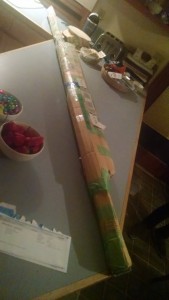
Here’s proof. I wrote “Archery Equipment” before I left hostfam’s house in an effort to expand sensei’s “弓” idea and in hopes that they’d count it as sports equipment.
But they did. Both my overweight suitcase and my bowpackage. Not a single thing went wrong. When I went back to my Mom’s house I unwrapped my bow and arrows right away. It was clear that security had opened up both the bow’s cardboard wrapping and the quiver’s added-on compartment. But what was funny was that it looked like on both, they didn’t bother to open the whole thing. Just a bit of the tops of each to see inside. Good for them. Even when I had scissors I had trouble battling sensei’s duct tape job.
And yes, it still felt normal unwrapping and unzipping my packages on the kitchen floor. But I realized that although it may have been a bit disappointing at first, that was actually kind of amazing. I had so acclimated to Japan and become so comfortable there that moving from one “normal” to another “normal” was hardly a big deal. There weren’t any foods I was really craving, or places I needed to see. Ordering at a restaurant in the US felt just the same as in Japan because, well, I was used to both. It just felt like home. But home, in America.
But in reality, there have been a few bumps since then.
One of the things I’ve had to do recently was to go to the DMV. If there was going to be anything that gave me a bit of culture shock, it was going to be that. And it honestly didn’t really disappoint.
Maybe “shock” is the wrong word after all, since it really is more of a dull reminder that things like these are just different in America. The guy in the DMV with the Hooters hat on backwards in particular was a nice reminder that I was back in Idaho.
And later at the bank, there was a long line for the next teller. There was an awkward employee standing next to us, shifting from leg to leg, telling us in a stuttering voice that she was very sorry for the wait and that she appreciates us standing here. Also that there was “coffee for you guys, if anyone wants any.” I somehow felt much less comfortable with this person hovering over me (actually, she was quite short but that’s beside the point). I don’t need someone to be my friend or pretend to be my buddy. You’re my company and I’m your customer. No need to pretend like it’s anything more than that. Sure, I appreciate the odd personal touch here and there, but if you mess up, apologize properly, take care of my business, and do better next time. That feel far more welcoming and personal to me. I guess Japan has changed me a bit.
There have been a couple other things I’ve noticed. Things about the US I’d forgotten about or things about Japan I didn’t know I’d remember.
The smells. Stepping onto the first airplane headed to the US I suddenly remembered how somebody else told me the US smelled: “like bubblegum.” I disregarded this at first in the plane, since people were probably chewing gum in the plane anyways, but smells have continued to remind me I’m back in the US. Mostly people smells, to be honest. I’ve already mentioned the cold toilet seats, but I feel like I need to mention it again to really get the point home.
I also am used to more pauses and quietness in conversations. I thought that it would be difficult for me to shut up while someone else was talking, since its an integral part of Japanese conversations to respond to your conversation partner in-time. But I didn’t think about the time between thoughts. When I’ve been talking to my friends, I feel I sometimes have trouble keeping up a bit and find myself lingering a bit in the silences.
There is so much space. On the streets. On the sidewalks. In ‘tiny’ houses. Where is everyone? Is everything ok? I’m actually less affected by this than I thought I would be, but it still pops every once in a while.
I’m totally oriented to the left. In Japan, cars drive on the left, trains run on the left, and people walk on the left. It’s the opposite in the US. This may be a small thing but has surprisingly big consequences in everyday life. When you come to an obstacle with a friend, do you go to the right or the left? The other day, I went far to the left, since I was on the left, to make room for my friend who I thought would be turning with me. But no. She went to the right. I was left far away from her and on the other side of the aisle. And when you accidentally block someone’s path, do you slide to the left or the right? I’ve learned to just stay still now, because I’m bound to mess up.
Yesterday I saw a bee and thought, soon it’ll be the season for Giant Hornets. Very thankful that’s not true. Praying for my friends back in Japan.
On the plane back I had a thought that made me smile as I looked out the window, headed towards the runway.
I’d been too caught up in my experience in Kyoto to realize how amazing it was. How much it had changed me. I started to realize right then how crazy it all was. But that didn’t make me sad. I wasn’t sad that I hadn’t realized how wonderful it was until then. that For some reason, I didn’t feel that way at all. I felt excited.
I would finally be able to appreciate it. Coming back to my friends and family, I’d be able to see how much I’d changed and how much I’d experienced. I had no gauge on that while I was in Japan.
Right then, it really felt like things had only just begun.
I’m still smiling.
Jesse

Late spring in Kyoto. Taken at Ryoanji on my second-to-last day.
